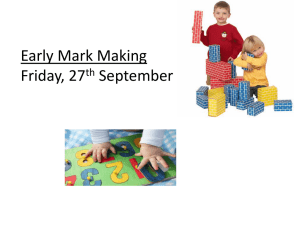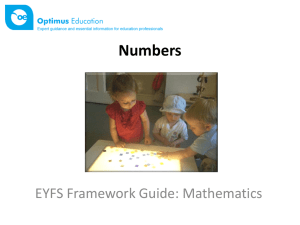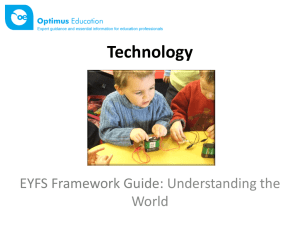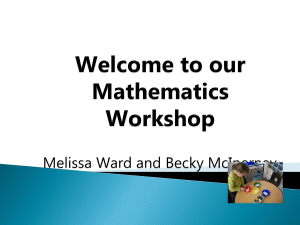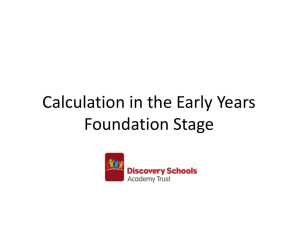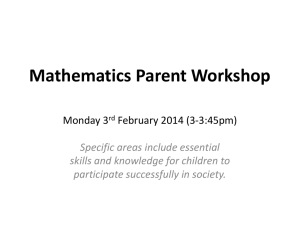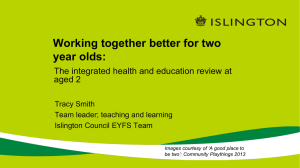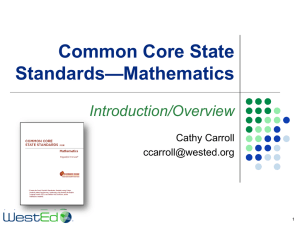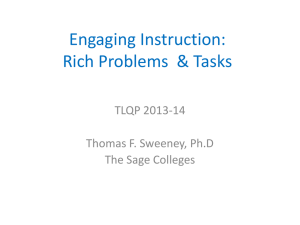Shape, space and measures
advertisement
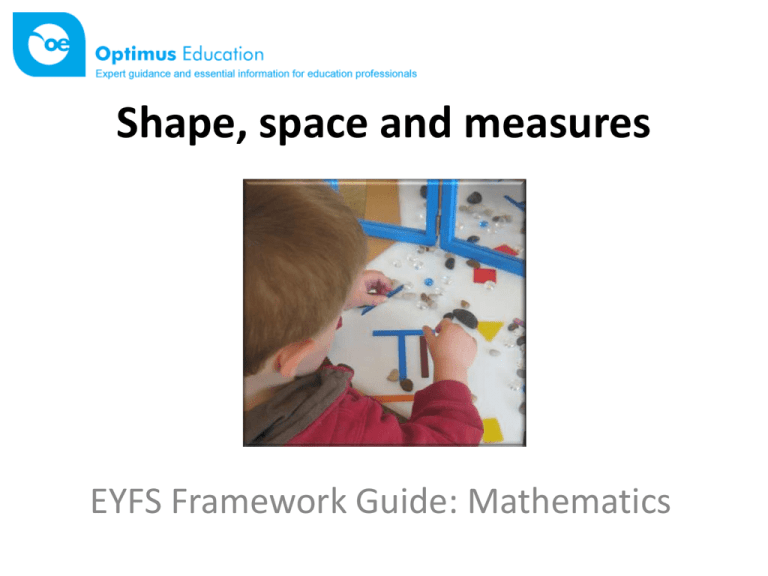
Shape, space and measures EYFS Framework Guide: Mathematics What is Mathematics? In the EYFS framework, Mathematics (M) is one of the four specific areas of learning. Mathematics involves giving children opportunities to know, and talk about, patterns and the properties of flat and solid shapes. It also involves children in using everyday language to describe and compare size, weight, capacity, time, position and distance. Mathematics also involves providing children with opportunities to practise and improve their skills in counting numbers and calculating simple addition problems. Two aspects of Mathematics in the EYFS Numbers Shape, space and measures Developing skills with shape, space and measures Mathematics covers the area of learning and development which was called ‘Problem solving, reasoning and numeracy’ in the original EYFS framework. Shape, space and measures’ has not changed its name. Babies’ and children’s mathematical development occurs as they seek to make patterns, make connections and recognise relationships as they learn about sorting and matching and developing an understanding of shape, space and measures. Practitioners can make the most of the mathematical potential of the outdoor environment by encouraging children to discover things about shape, distance and measures, through their physical play. How can we support young children to develop their skills with shape, space and measures? Attitudes and ethos The physical environment Links to the prime areas of learning Supporting different ways of learning Building partnerships with parents Our attitudes and ethos • Are all practitioners working with the Under Twos knowledgeable about how to support young children’s learning and development in shape, space and measures? • Do any of the practitioners working with the youngest children keep up to date with the latest thinking about how babies and toddlers learn about mathematics? • How well do all practitioners recognise the mathematical learning which is taking place in everyday situations? • As a setting which provides early educational opportunities throughout the birth to five age range, are all staff familiar with the requirements of the EYFS in shape, space and measures for all age groups to ensure consistency and the planning of appropriate learning opportunities? Physical environment • Do all practitioners create an enabling environment which supports children’s learning and development in shape, space and measures? • When resources are selected for all age groups is this area of learning and development taken into account? • Does the baby room include black and white resources which support children’s understanding of pattern, shape and space? • Do we provide a range of interesting opportunities, such as an overhead projector or light box, for the children to develop their knowledge, understanding and skills in shape, space and measures? • Do we make good use of the outdoor environment and the local area to look for shapes, experience spaces and explore opportunities for using measures, including time, distance, speed, length, weight and capacity? Links to the prime areas of learning Mathematical development begins at a very early age, long before a child is three. ‘Practitioners working with the youngest children should focus on the prime areas, but also recognise that the foundations of all areas of learning are laid from birth’- for example literacy in the very early sharing of books.’ [Tickell Review of the EYFS, 2011] • How good are we at taking every opportunity to talk to the children about the different shapes, sizes and patterns they can see around them? • Are all staff confident in using the mathematical vocabulary relevant to shape, space and measures, for example naming 2-D and 3-D shapes correctly and using the correct mathematical terms to describe these shapes? • How often do children have the opportunity to investigate shape and spaces on a large scale, including out of doors? • Do we use role play, construction, small world play and physical play out of doors as contexts for learning about shape, space and measures? Links to the prime areas of learning Mathematical development begins at a very early age, long before a child is three. ‘Practitioners working with the youngest children should focus on the prime areas, but also recognise that the foundations of all areas of learning are laid from birth’- for example literacy in the very early sharing of books.’ [Tickell Review of the EYFS, 2011] • Do we use the wealth of opportunities which children’s play offers to use appropriate language to describe shape, space and measures? • Are all staff confident in using the mathematical vocabulary relevant to shape, space and measures, for example naming 2-D and 3-D shapes correctly and using the correct mathematical terms to describe these shapes? • Do children have access to a range of books, puzzles and construction materials which will support their learning and development in this area. • How often do children have the opportunity to investigate shape and spaces on a large scale, including out of doors? Supporting different ways of learning • How well do practitioners observe individual children’s interests in shape, pattern and measures? • Are all practitioners aware of the different ways in which they could present resources which support shape, space and measures to appeal to both boys and girls? • Do we ensure that we include appropriate activities which will engage visual, auditory or kinaesthetic learners? • When resources are chosen for the children to use in this area of learning to we take into account their interests and fascinations? Building partnerships with parents • Could we provide parents with guidance which will help them to support their children’s learning and development in shape, space and measures? • Are parents made aware of the mathematical opportunities in sharing puzzles, pop-up books with flaps, and different types of building blocks with their babies and young children? Building partnerships with parents • Could we provide parents with guidance which will help them to support their children’s learning and development in shape, space and measures? • Are parents made aware of the mathematical opportunities in sharing puzzles, pop-up books with flaps, and different types of building blocks with their babies and young children? • Do we talk to parents about simple and inexpensive ways of supporting their children’s learning in this area of mathematics, such as involve them in daily activities such as cooking or baking or making a collection of buttons in a special box or tin for their child to arrange, order, sort and count. • How well do we involve parents in the activities we plan for children? Arrange a walk in the local community, to which parents are invited, where you can model how to look for shapes, patterns and opportunities to use a variety of measures in the local rural or built environment.

